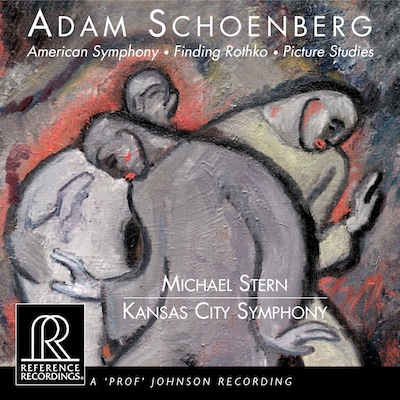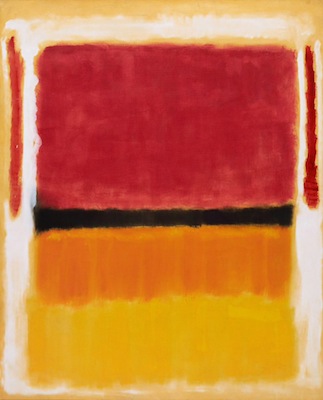
Adam Schoenberg: “Finding Rothko” and other orchestral works

Adam Schoenberg: Finding Rothko, American Symphony, and Picture Studies.
Kansas City Symphony, Michael Stern, conductor.
Reference Recordings RR-139 Hybrid+MCH SACD and Downloads
David Frost, producer; Keith O. Johnson, engineer and mastering engineer.
My recent entry on the Morton Feldman musical work inspired by Houston’s Rothko Chapel noted that Rothko’s huge canvasses displayed there had also inspired Peter Gabriel’s song “Fourteen Paintings.” Four different Mark Rothko paintings that span the years 1949 to 1959 more recently inspired American composer Adam Schoenberg (b.1980) to write Finding Rothko, an orchestral work in four movements identified by the colors Orange, Yellow, Red, and Wine. Finding Rothko is concise, tonal, melodic, and accessible, with brilliant orchestration.
The obvious parallel is to Arthur Bliss’ A Colour Symphony of 1922 (which perhaps was an un-acknowledged inspiration). A Colour Symphony‘s movements are also named after colors; in Bliss’ case, the heraldic colors Purple, Red, Blue, and Green.
More ponderings and generous sound samples after the jump.
Adam Schoenberg, whose style as far as I tell has almost no overlap with Arnold Schoenberg’s Second Viennese School music (but perhaps there is some commonality with Arnold’s early work Gurrelieder) first encountered Rothko paintings while a doctoral candidate at the Juilliard School. I gather that Adam’s work’s title Finding Rothko refers both to Schoenberg’s process of choosing four paintings from Rothko’s entire catalog and to the “detective work” of locating and arranging a private viewing of the painting that inspired the final movement “Wine.”
Here’s the painting that inspired the first movement, “Orange.” But please keep in mind that the original canvas measures 81 1/2 by 66 inches, roughly six feet ten inches high and five feet six inches wide. So, in real life and in a gallery setting, the impact would be far greater than a 400-pixel high reproduction might suggest.

Untitled (1949) (Violet, Black, Orange, Yellow on White and Red).
Solomon R. Guggenheim Museum, New York. Gift, Elaine and Werner Dannheisser and The Dannheisser Foundation, 1978.
© 1998 Kate Rothko Prizel and Christopher Rothko/Artists Rights Society (ARS), New York.
Adam Schoenberg’s Finding Rothko is in four movements played without pauses; it has a running time of just about 15 minutes. In order to set off the movements, Schoenberg wrote a brief motto or theme to represent Rothko himself. The “Rothko Theme” appears at the opening of the work, and then in some subtly changed form before each new movement, and (at least in spirit) returns at the end of the work.
I think that the most distinctive feature of Finding Rothko is that it exhibits what I call “Prairie Protestant Hymnody,” which is a term I made up (after all, isn’t music criticism just the art of making things up?). Be that as it may, I am sure that you will recognize Prairie Protestant Hymnody when you hear it—the first half minute of the first movement (“Orange”) of Finding Rothko is as good an example as any. By Prairie Protestant Hymnody I mean a certain style of high, wide chords in a yearning, searching, or questing melodic progression—the kind of writing and orchestration heard in Roy Harris’ Third Symphony as well as many works by Howard Hanson and Aaron Copland and even from time to time Samuel Barber.
Finding Rothko was a student work, at least in the senses that Adam Schoenberg was enrolled in a program at Juilliard during the time he wrote it; and, more to the point, he was studying under John Corigliano. In the liner notes, Schoenberg recalls:
For four consecutive days, I spent hours in his studio while he asked me endless questions.
We went over each measure linearly and vertically, and what I learned was immeasurable.
The works on this recording are arranged chronologically, and while I am concentrating on the earliest work because of its association with Mark Rothko, the later works are more substantial and compositionally diverse. That said, there is throughout a sense that Adam Schoenberg is writing in a “Los Angeles School” idiom that usually has a pinkie toe (if not one or two footsies) in film music.
There are echoes or borrowings from Respighi (not that Respighi ever lived in Los Angeles) and Castelnuovo-Tedesco and of course, John Williams. (And at least to me, the far less well-known composers Russ Garcia and Magne Amdahl.) Adam Schoenberg is a deft, brilliant, and innovative orchestrator with an ear for lovely sonorities and lovely melodies. To that extent, the resemblances are very strong to the above-mentioned composers.
On this all-premières recording, the orchestral playing is first-rate, and the recorded sound excellent. (This recording is available on the streaming service Tidal; but, once again, they seem to have scumbled the track order, interleaving different movements from different works quite randomly.)
Highly recommended for those in search of something that is contemporary, but not needlessly confrontational. Here are the Finding Rothko sound samples:
1. Adam Schoenberg: Finding Rothko, mvmt 1 “Orange”
2. Adam Schoenberg: Finding Rothko; mvmt 2 “Yellow”
3. Adam Schoenberg: Finding Rothko; mvmt 3 “Red”
4. Adam Schoenberg: Finding Rothko; mvmt 4 “Wine” (conclusion)
# # #



A great recording! Nice pick.